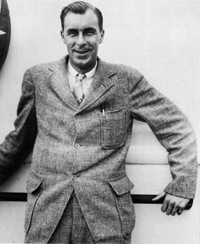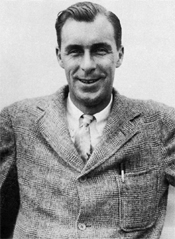That Mad, Crazy Thrill
William T. Tilden II
 |
William Tatum Tilden II, the original tennis bug. |
There is no sensation in the sporting world so thoroughly enjoyable to me as that when I meet a tennis ball just right in the very middle of my racquet and smack it, just right, where my opponent should be but is not.
I enjoy the ring of the baseball off my bat (if I ever manage to hit one), the thrill that comes as the golf ball sails down the course from my driver (it usually sails out into the rough or else ten feet down the course), the thud of the football as it goes (possibly 15 yards) off my toe, the ice under my skates (or my back, more often); but none of these afford me the same mad thrill of crazy excitement as grips me when I smack a tennis ball, "just right." Just because I am a tennis bug.
I am one of those poor bugs that will sit out, until eight o'clock at night, together with other tennis bugs, to watch a couple of kids, or old men, or dubs, finish a match that means nothing. I am writing this book in the hope that somewhere in the world is one other tennis bug who will have as much fun reading it as I have had writing it.
This book is for the tennis bug, because it is primarily advanced tennis. Anyone can go out to a teaching professional and be taught strokes. They may be good or they may be bad (the strokes I mean), according to the teaching professional. My experience tells me that in nine cases out of ten they will be bad. Teaching professionals are for beginners, novices, and for the Great Dub--to relieve him of his unwelcome burden of that title.
Only someone who has been through the mill of championship tennis, can tell the inside story of tennis,
its fine points, its science and its art. It is something of the inside story of match play, from the technical angle,
that I am writing.
The Third Party in the Match
Most tennis players look upon the ball that is used as merely something to hit. It is not an individual, separate factor in their play, like their opponent. They use it as a means to an end. Let me suggest the ball for a moment as an individual. It is a third party in the match. Will this third party be on your side or against you? It is up to you.
The ball will do as it is told. Suggest (with your racquet, not your tongue) that the ball curve this way or that and it obeys. It is the power of your suggestion that determines how well your wishes are carried out.
Every ball has an outside and inside edge every time it comes to you. I admit it is round, yet to the player the side nearest you is its inside edge and that away from you its outside edge; and the edge you hit determines the curve and spin of the ball on your return. Why should we curve or spin the ball?
We do it to gain control of our shot.
We do it to fool our opponent.
We do it by accident.
Let me recommend that you confine your activities to the first two of these, for the third will happen anyway. I prefer to make the ball follow my suggestions, rather than chase it around at those of my opponent.
Let me open this discussion by a sound tennis maxim: "Never give your opponent a chance to make a shot he likes." The whole object of putting twist, spin, cut, curve, or whatever term you prefer to describe your control of your stroke on the ball, is to force your opponent into error.
Breaking Your Opponent
I may sound unsporting when I claim that the primary object of tennis is to break up your opponent's game, but it is my honest belief that no man is defeated until his game is crushed, or at least weakened. Nothing so upsets a man's mental and physical poise as to be continually led into error. I have often seen players collapse in a match after they have netted or driven out a crucial point which they should have won.
It is with a view not only to your own stroke but to the effect on your opponent that leads me to say, "never make any stroke without imparting a conscious, deliberate and intentional spin to the ball."
There are two fundamental facts as to spin:
1. The more spin the less pace, and vice versa.
2. Top spin tends to drop; slice or cut spin tends to rise.
Remember, that where a shot is designed to defend, the spin should tend to bring the ball toward the center of the court; when a shot is used for attack, the spin can be used to curve the ball either way, according to the direction of your shot.
Slice shots tend to curve toward the sideline closest to the point from which the stroke is made, and are thus apt to go out over the side. Top spin tends to curve the ball toward the center of the court. Every player who desires to attain championship heights must understand the value of spin on the ball. Spin means control. Knowledge of how to use it assures a player of a versatile defense and attack.
The American twist, or kick serve, is one of the greatest assets to a player. It is the service which is the foundation of my delivery, although I mix it up with the slice. The racquet travels from left to right and up over the ball, imparting a distinct "out- drop" top spin. The ball curves from the server's right to left and bounces from his left to right and high or, usually to your opponent's backhand, generally his weakest point.
The slice spin serve causes it to curve and bounce from the server's right to his left, or, in other words, toward his opponent's forehand. The object of this service spin is to force your opponent to reach for his return, causing his shot to either slide off his racquet or to pop weakly in the air.
I am discussing twists or spins in detail because, in service, spin rather than speed is the essential point. It is by twist and placement rather than speed that you can put your opponent on the defensive at the opening of the point. Speed alone is easy to handle. It must beat the other man clean or his return will force you on the defensive by turning your own speed back on you.
The cannon ball service, a delivery of which I am supposed to be a leading exponent, is almost without twist, hit with a flat racquet face and quite incapable of control or placement except by accident. Most players handle my cannon-ball flat service more easily than either of my spin deliveries. So I strongly urge, from personal experience, base your service on a twist of some sort.
Spin in Play
Let me turn to the use of spin in actual play, once the service has been delivered. Remember that, as a general rule, top spin or a flat, twistless shot is offensive, the basis for attack; while a slice, or undercut, backspin shot is defensive. Top spin carries control, speed and pace. Under-cut carries control and direction but not speed.
Against the net man, who is storming the barrier, all passing shots should be hit with top spin. In the first place, top spin will drop more quickly and force him to volley up from below the top of the net. Secondly, the shot carries more speed and as much control as a slice. The reverse of the spin of a top shot when it is volleyed tends to cause it to rise up in the air unless the volley is perfectly hit, while a slice, when volleyed, pulls down off the racquet, often for a kill. There can be no two views about the advantage of top spin over chop or slice against a net attack when striving for a passing shot.
Let us consider the defensive lob for a moment, the attempt to gain time when you are forced off your feet by your opponent's attack. Here the undercut lob is the better choice. The undercut tends to hold the ball longer in the air. The slight gain in time itself may give you time to recover your position, even if your opponent makes his kill. Top spin lobs, or the so-called "loop drive," are useful as a surprise, never as a sound defense.
Admitting the foregoing, the question arises as to spin from the baseline when both players remain in the backcourt. The ideal combination is a mixture of the two. Personally I study my man and lay my attack accordingly.
I form the basis of my game on a top spin drive, using the slice shot to mix pace, speed and depth. The top spin shot will win outright more often than the undercut, owing to its greater speed and severity, but I am of the opinion that the undercut shot is more apt to force your opponent into error. In the backcourt, the undercut shot, with its tantalizing hesitation of bounce, can sometimes advance to almost equal footing with the top spin shot. There is less labor involved in making the slice shot, while it's irregularity of spin is greater than the topspin shot and therefore harder to judge accurately.
Certain players are peculiarly susceptible to error from certain twists. If I were to lay down a general principle to follow, I would advise slicing to a player who prefers a high bounding ball to drive and top spin driving a man who likes to slice his return.




